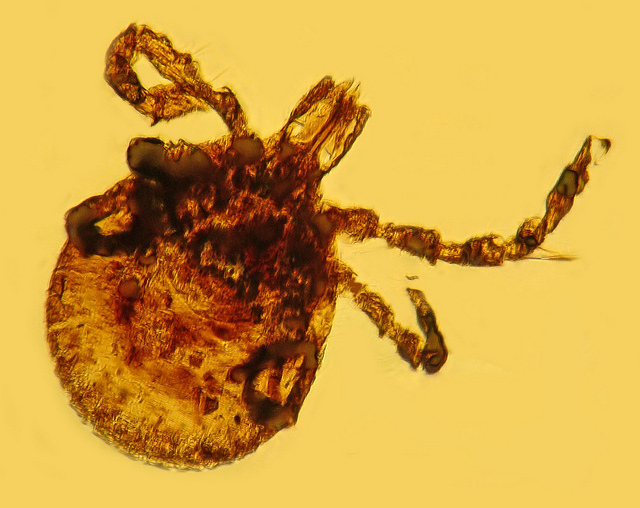Ancient Lyme Disease Bacteria Found in 15-Million-Year-Old Tick Fossils

The oldest known evidence of Lyme disease may lie in ticks that were entombed in amber at least 15 million years ago, scientists announced.
The researchers investigated four fossilized ticks that had been trapped in chunks of amber found in the Dominican Republic. Inside the ticks' bodies, the scientists saw a large population of cells that looked like the squiggly shaped spirochete cells of the Borrelia genus — a type of bacteria that causes Lyme disease today.
Bacteria, which arose on the planet 3.6 billion years ago, rarely survive in the fossil record. But amber, the hardened resin from oozing trees, can preserve soft tissues and microscopic cells that would otherwise degrade over time. In recent years, scientists have discovered the 100-million-year-old gut microbes of a termite and 40-million-year-old sperm from an insect-like springtail, both trapped in amber. [Photos: Ancient Life Trapped in Amber]
The newfound bacteria species was dubbed Palaeoborrelia dominicana. The findings suggest illnesses like Lyme disease and other tick-borne diseases may have been plaguing animals long before humans ever walked Earth.
Today, ticks are more significant disease-carrying insects than mosquitos in the United States, Europe and Asia, said entomologist George Poinar, Jr., a professor emeritus at Oregon State University, lead author of the study detailed in the journal Historical Biology last month.
"They can carry bacteria that cause a wide range of diseases, affect many different animal species, and often are not even understood or recognized by doctors," Poinar said in a statement. "It's likely that many ailments in human history for which doctors had no explanation have been caused by tick-borne disease."
Lyme disease, for example, wasn't formally recognized until the 1970s even though it affects thousands of people each year. In 2009, there were 30,000 confirmed cases of Lyme disease in the United States, according to the Centers for Disease Control and Prevention. Humans acquire the disease when bitten by ticks that carry Borrelia bacteria. But because it has symptoms that overlap with many other disorders — including rash, aches, fatigue and fever — Lyme disease is often misdiagnosed.
Sign up for the Live Science daily newsletter now
Get the world’s most fascinating discoveries delivered straight to your inbox.
The oldest documented case of Lyme disease in humans comes from the famous 5,300-year-old ice mummy dubbed Ötzi, discovered in the Eastern Alps about 20 years ago. In a 2012 study detailed in the journal Nature Communications, scientists said they found genetic material for the Borrelia bacteria in the iceman.
"Before he was frozen in the glacier, the iceman was probably already in misery from Lyme disease," Poinar said. "He had a lot of health problems and was really a mess."
Follow Megan Gannon on Twitter and Google+. Follow us @livescience, Facebook & Google+. Original article on Live Science.










